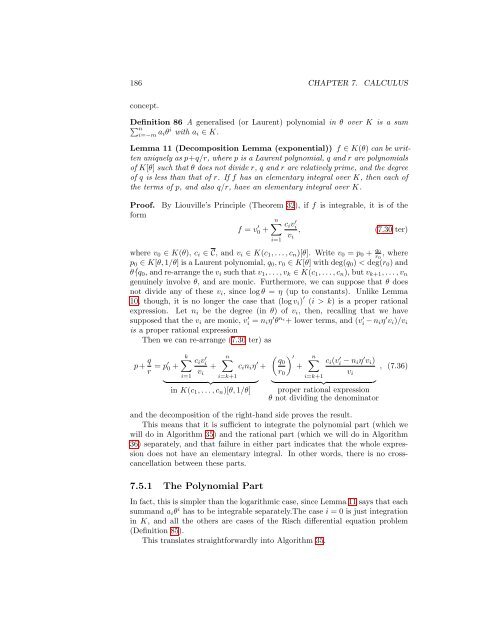Contents - Student subdomain for University of Bath
Contents - Student subdomain for University of Bath
Contents - Student subdomain for University of Bath
Create successful ePaper yourself
Turn your PDF publications into a flip-book with our unique Google optimized e-Paper software.
186 CHAPTER 7. CALCULUS<br />
concept.<br />
Definition 86 A generalised (or Laurent) polynomial in θ over K is a sum<br />
∑ n<br />
i=−m a iθ i with a i ∈ K.<br />
Lemma 11 (Decomposition Lemma (exponential)) f ∈ K(θ) can be written<br />
uniquely as p+q/r, where p is a Laurent polynomial, q and r are polynomials<br />
<strong>of</strong> K[θ] such that θ does not divide r, q and r are relatively prime, and the degree<br />
<strong>of</strong> q is less than that <strong>of</strong> r. If f has an elementary integral over K, then each <strong>of</strong><br />
the terms <strong>of</strong> p, and also q/r, have an elementary integral over K.<br />
Pro<strong>of</strong>.<br />
<strong>for</strong>m<br />
By Liouville’s Principle (Theorem 32), if f is integrable, it is <strong>of</strong> the<br />
f = v ′ 0 +<br />
n∑<br />
i=1<br />
c i v ′ i<br />
v i<br />
, (7.30 ter)<br />
where v 0 ∈ K(θ), c i ∈ C, and v i ∈ K(c 1 , . . . , c n )[θ]. Write v 0 = p 0 + q0<br />
r 0<br />
, where<br />
p 0 ∈ K[θ, 1/θ] is a Laurent polynomial, q 0 , r 0 ∈ K[θ] with deg(q 0 ) < deg(r 0 ) and<br />
θ̸ |q 0 , and re-arrange the v i such that v 1 , . . . , v k ∈ K(c 1 , . . . , c n ), but v k+1 , . . . , v n<br />
genuinely involve θ, and are monic. Furthermore, we can suppose that θ does<br />
not divide any <strong>of</strong> these v i , since log θ = η (up to constants). Unlike Lemma<br />
10, though, it is no longer the case that (log v i ) ′ (i > k) is a proper rational<br />
expression. Let n i be the degree (in θ) <strong>of</strong> v i , then, recalling that we have<br />
supposed that the v i are monic, v ′ i = n iη ′ θ ni + lower terms, and (v ′ i − n iη ′ v i )/v i<br />
is a proper rational expression<br />
Then we can re-arrange (7.30 ter) as<br />
p + q k∑<br />
r = c i v ′ n∑<br />
p′ i<br />
0 + + c i n i η ′ +<br />
v<br />
i=1 i<br />
i=k+1<br />
} {{ }<br />
in K(c 1 , . . . , c n )[θ, 1/θ]<br />
(<br />
q0<br />
n∑<br />
c i (v ′ i − n iη ′ v i )<br />
v i<br />
) ′<br />
+<br />
r 0<br />
i=k+1<br />
} {{ }<br />
proper rational expression<br />
θ not dividing the denominator<br />
, (7.36)<br />
and the decomposition <strong>of</strong> the right-hand side proves the result.<br />
This means that it is sufficient to integrate the polynomial part (which we<br />
will do in Algorithm 35) and the rational part (which we will do in Algorithm<br />
36) separately, and that failure in either part indicates that the whole expression<br />
does not have an elementary integral. In other words, there is no crosscancellation<br />
between these parts.<br />
7.5.1 The Polynomial Part<br />
In fact, this is simpler than the logarithmic case, since Lemma 11 says that each<br />
summand a i θ i has to be integrable separately.The case i = 0 is just integration<br />
in K, and all the others are cases <strong>of</strong> the Risch differential equation problem<br />
(Definition 85).<br />
This translates straight<strong>for</strong>wardly into Algorithm 35.












![[Luyben] Process Mod.. - Student subdomain for University of Bath](https://img.yumpu.com/26471077/1/171x260/luyben-process-mod-student-subdomain-for-university-of-bath.jpg?quality=85)



